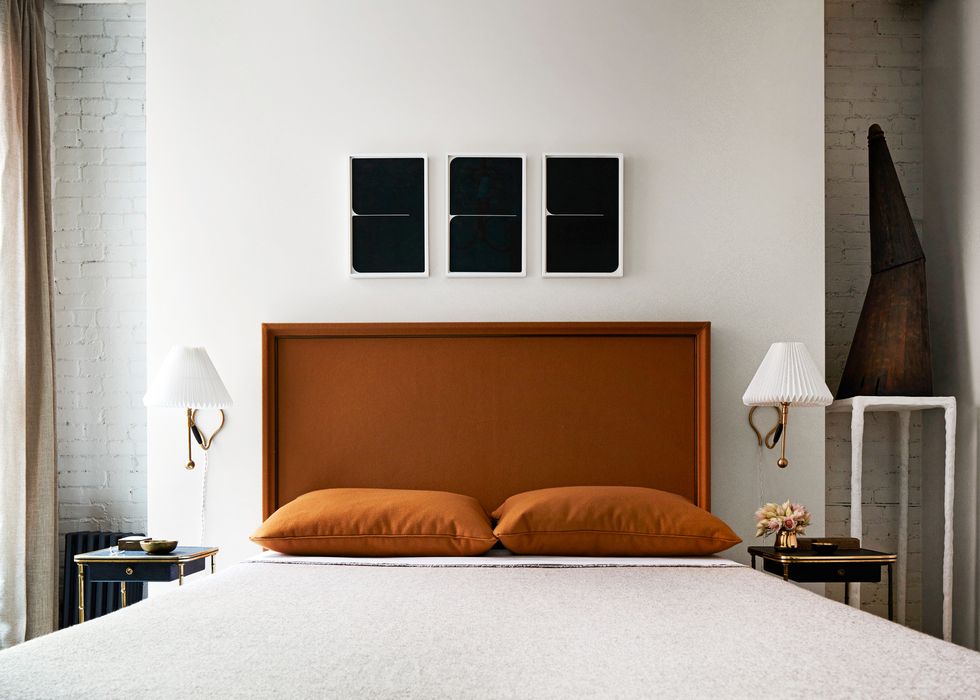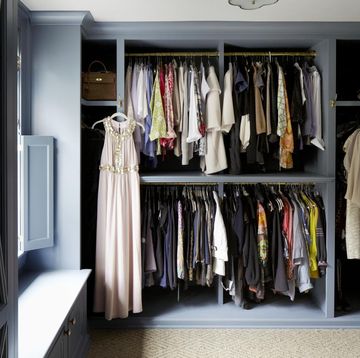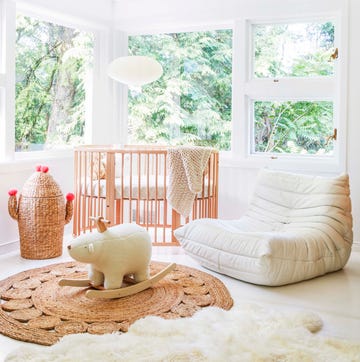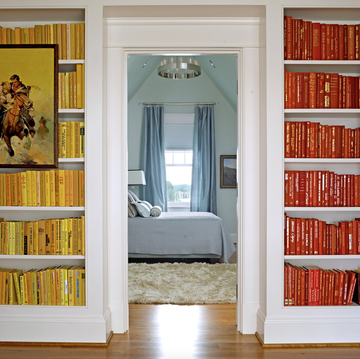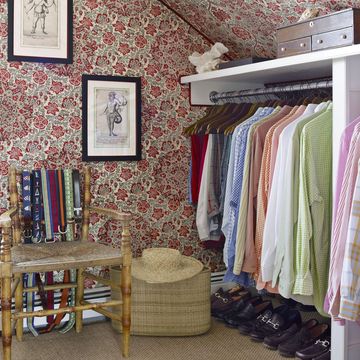A clean, clutter-free home can do wonders. Apart from the psychological benefits we get from organizing after the process, decluttering your home means you’ll ultimately be left with the items that best serve you. In the end, you'll be left with functional products, like a clear acrylic organizer that makes it easy to view your items, and pretty pieces you adore, like meaningful artwork.
To guide you through the never-ending task of decluttering your home—and make it less overwhelming—we’ve laid out tried-and-true tips. Keep these in mind, and you’ll be able to easily edit your home.
1. Determine your goals.
Before diving into decluttering your home, figure out what you want to accomplish first. Which rooms do you want to tackle? Whether you want to declutter your home office or your entire residence, determine what’s working in the space and what’s not. Once you know the room’s faults, you can prepare to fix them.
2. Don’t use your home like a storage unit.
Simply removing items from a room and throwing them into your storage space isn’t effective. Take it from organizing expert Marie Kondo, who once explained: "Storage experts are hoarders. Putting things away creates the illusion that the clutter problem has been solved." You only have so much storage space to work with, no matter if it’s a closet, basement, or attic. Use your storage wisely so that what you put in it doesn’t eventually become clutter.
3. Figure out what items bring you joy.
This is where another Marie Kondo tip comes in: Only keep items that bring you joy. This doesn’t mean they have to bring you joy 24/7, though. If you have something seasonal, like a ton of Christmas ornaments, or a collection that you don’t always want on display, you can neatly stow those away until they’re needed.
4. Ask yourself if an item is “the best, the favorite, or necessary.”
Coined by author and creator of the Simplified Planner Emily Ley, this little mantra can help you determine what items to keep and which ones to toss. If you have, say, a ton of food storage containers and water bottles, narrow the items within those categories down to your top choices.
5. Start small.
“If you need some motivation and want to see and feel what a decluttered area can do for you, start with a small space that you see every day,” Ley shared in a blog post. She continued: “Maybe it’s that bathroom cabinet or a kitchen drawer. Decide on a room and continue in that room until you’ve gone through every area.”
6. Determine a reasonable time you can dedicate to the task.
You don’t have to declutter your entire kitchen in one night. If you have a limited amount of free time each day, dedicate some of it to smaller tasks within a room. For example, you can do one drawer in your bathroom each night. Ley recommends starting with the easiest one, so you feel accomplished.
7. Save big projects for the weekend.
Try saving big projects for the weekend. This will give you a better chance of feeling satisfied with the work you’ve accomplished since you’ll hopefully have a lengthier period to work on it.
8. Don’t waste time looking for storage solutions.
If your space is extremely cluttered, don’t bother trying to reorganize it all. There are only so many space-saving hacks and products you can use. Once you get down to the items you truly need, you’ll be able to store and organize them quicker.
9. Don’t hold onto something just because it was a gift.
It’s hard to let go of something that a loved one gave you, but it’s really the acts of giving and receiving that count. If the gift isn’t something you need or like, don’t feel guilty about letting it go. Maybe it will serve someone else better!
10. Pretend you’re moving.
Moving is no easy feat, which is why pretending you’re doing it as you declutter a space will help you weed out your belongings. Plus, if you do move in the future, you won’t have to spend so much time decluttering during the process.
11. Follow the one-in-one-out rule.
To better maintain a decluttered space, promise that you’ll get rid of one item for every new item you bring into your house. With this method, you won’t start to amass a ton of stuff.
12. Use the 90/90 rule.
When following The Minimalists’ 90/90 rule, start by looking at a possession. Ask yourself if you’ve used it in the last 90 days. If you haven’t, will you use it in the next 90? If you don’t think you will, let it go. Note that the specific number is flexible. For you, it could be longer or shorter. In any case, the method will help you decide what’s actually necessary to keep.
13. Try the ex test.
Another trick to determine what items you actually love? Ask yourself if you’d contact an ex to get it back. They could be a romantic partner or even a friend you parted with on rocky terms. If you wouldn’t go through that emotional process to get the item back, it’s likely not worth keeping.
14. Shop your own items for others.
Whether you’re going through books, clothes, or decor, shop your belongings with the intention of picking items out to give to your loved ones. This will make you overall more excited about the decluttering process. Who doesn’t love to shop, especially when you don’t have to actually swipe your credit card again?
15. Use the hanger trick for clothes.
Not quite sure which clothes you wear and which ones you don’t? Do a little experiment to find out by flipping the hangers in your closet. After a certain amount of time, like three months, check back to see which hangers you flipped the correct way to wear. In the end, you’ll be left with garments that it's likely time to say goodbye to.
Love shopping for your home and scoring the best deals? We can help.
16. Ask yourself if it’s something you’d purchase now.
If you didn’t have the item you’re debating on tossing, determine if it’s something you’d buy today. This can help you get rid of anything from clothing you’ve outgrown to decor that no longer fits your style.
17. Remember that you can invest in more items in the future.
As you figure out which items spark joy, remember you can buy more things in the future. Often, the thought of having to repurchase something you once owned and got rid of can lead you to keep more than you currently need. Know that if something isn’t serving you right now, you’ll gain a lot from letting it go and allowing yourself to buy it again down the road if necessary. Who knows, maybe you’ll forget you ever even had it!
18. Don’t let items pile up.
If you’re the type of person who lets clothes and accessories pile up on a chair in your bedroom, consider altering that habit. Use hooks or an easily accessible rack to hang hats, jackets, and more. If that’s still a bit too much, place a laundry hamper or basket near the chair, so you can still throw things in it quickly but maintain a neat look.
19. You don’t have to rid your home of a ton of items to declutter it.
With some serious reorganization and the purging of a few items, you can make a space clutter-free. You don’t have to always take the task to a deep spring cleaning level, especially if you’re working on decluttering a small area.
20. Tackle stacks of paper.
Paper can easily pile up—even with so much online these days. When going through paper clutter, ask if it’s something you should shred, file, or recycle. Sometimes, you might even want to shred and recycle certain papers. When filing items, consider if the paper can be scanned and stored digitally.
21. Set limits.
If you’re decluttering an area like your kitchen or closet, set a limit on how much space a certain item can take up. How many shelves in your closet can you realistically dedicate to shoes and accessories? How many kitchen cabinets can you reasonably fill with mugs?
22. Wait to buy organizers.
Organizing a recently decluttered space can be exciting, but don’t get too ahead of yourself. Wait to buy any new organizers until you know what items you’re working with.
23. You won't like an item you were never into in the first place.
Let’s call this the fitting room test. When you try a piece of clothing on in a fitting room and aren’t that thrilled about it, there’s a good chance you won’t like it anymore once you’ve bought it. So if you’re hanging onto an item you never really liked, get rid of it.
24. Keep flat surfaces clear.
An easy way to maintain a clean space is to keep flat surfaces free of a bunch of items. Whether it's your kitchen counters or the desk in your home office, less is more.
25. Don't wait for spring cleaning season.
If you only declutter your home in the spring, the process likely takes a good amount of time. If you do it often—and intentionally prevent clutter from amassing—the experience will be much less stressful.
26. Time yourself.
Before you embark on a decluttering session (and you eventually get distracted looking through old photo albums or collected treasures), set a timer. You don't necessarily have to rush, but the countdown of the clock may help you stay on track.
27. Get a second opinion.
Sometimes, our friends and family can help shed light on things—and that includes figuring out what's worth keeping and what's not. Turn to a trusted source for advice on what seems reasonable to toss.
28. Try selling items.
Need a little monetary motivation? Round up items and try to sell them. Take clothing to resale stores, list items through online marketplaces, or host a garage sale. Just make sure you give yourself a time limit so that you don't end up with a pile of items sitting around waiting to be sold, as it can often take some time if you go the online route!
29. Create a decluttering list.
If you're the type of person who loves a good list, create one for decluttering tasks. Outline all of the areas you want to declutter, make them part of your weekly chore routine, and check each one off as you go.
30. Donate extra items.
Give your extra clothing and home goods to those in need. With the intention to help places like women’s shelters and habitat charities, it'll be easier to part with items you no longer use but someone else certainly will.
31. Take before and after photos.
By taking before and after photos of your decluttering process, you'll be able to easily determine what needs to be done in the event that your space becomes cluttered again.
32. Don’t rush the process.
In her book, The Life-Changing Magic of Tidying Up: The Japanese Art of Decluttering and Organizing, Marie Kondo wrote: “Rebound occurs because people mistakenly believe they have tidied thoroughly, when in fact they have only sorted and stored things halfway." If you don’t take time to thoroughly declutter your space each time you do it, you’ll have more work in the end when you have to start over again in a week.
33. Decluttering is a marathon, not a sprint.
You can do a purge of your belongings, but that doesn’t mean you’ll never have to declutter your space again. The good news? It’ll get easier and quicker the more you do it.
Follow House Beautiful on Instagram.

Kelly Allen is the current Associate Editor at House Beautiful, where she covers design, pop culture, and travel for digital and the print magazine. She’s been with the team for nearly three years, attending industry events and covering a range of topics. When she’s not watching every new TV show and movie, she’s browsing vintage home stores, admiring hotel interiors, and wandering around New York City. She previously worked for Delish and Cosmopolitan. Follow her on Instagram.





